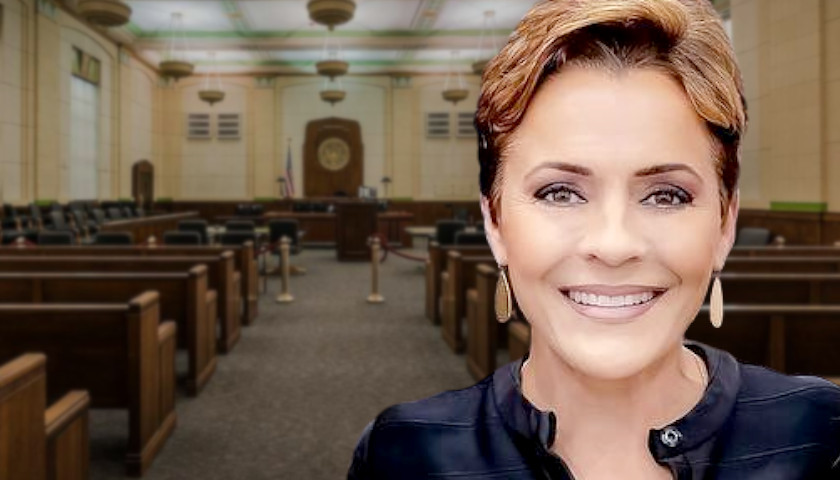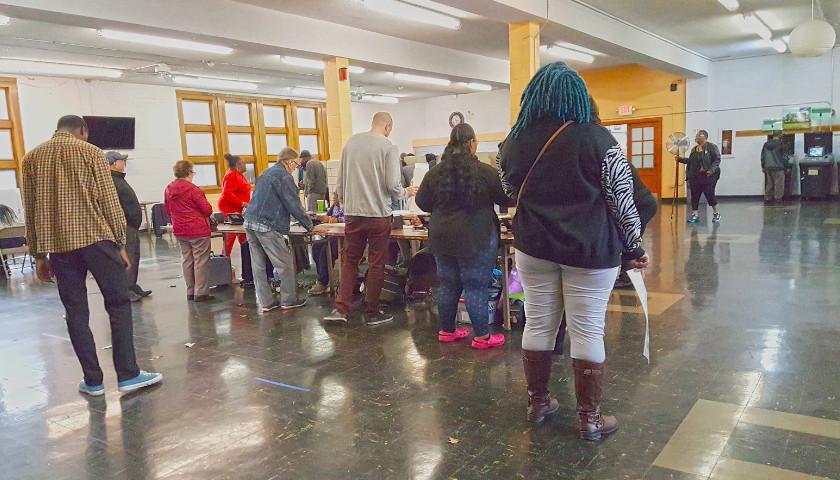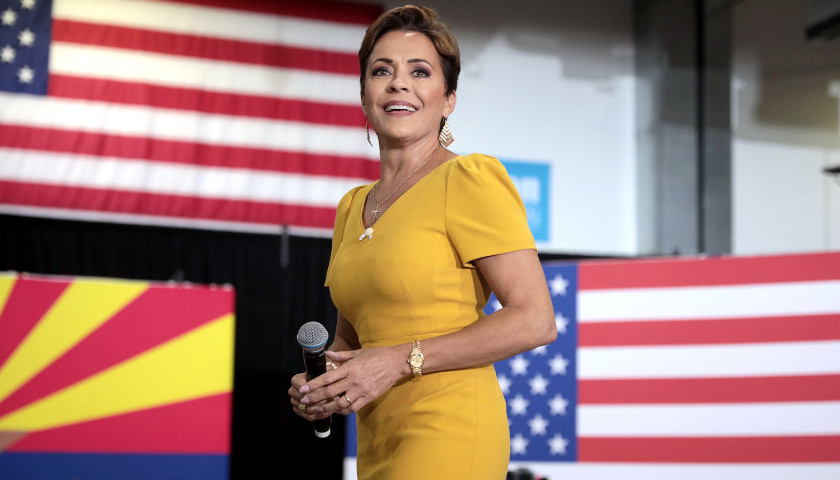As the second day of Kari Lake’s trial contesting Arizona’s gubernatorial election wrapped up Thursday, various election law attorneys provided their analysis on social media and videos. Some were optimistic that Maricopa County Superior Court Judge Peter Thompson would grant Lake relief, declaring her the winner or calling for a new election, but some were not as optimistic.
Robert Gouveia, an attorney in Scottsdale with his own legal podcast, provided a recap where he expressed his concern about the trial.
“What makes this case so difficult for Kari Lake, is it’s her burden to prove it,” he said. “They don’t have to negate anything. They just say ‘we did our job.’”
Gouveia cited the judge’s previous minute entry allowing the case to proceed based on the printer problems. Thompson said that Lake could present her case based on A.R.S. 16-672(A)(1), challenging an election “For misconduct on the part of election boards or any members thereof in any of the counties of the state, or on the part of any officer making or participating in a canvass for a state election.”
The judge said Lake would need to show for count two illegal tabulator configurations, 1) the “malfeasant person,” 2) the printer malfunction caused lost votes for the candidate, and 3) those votes would have affected the election. Count four was ballot chain of custody.
Gouveia then went over whether Lake’s attorneys were able to show those three elements. He said voter suppression alone should have been actionable for the court, but the judge wanted those three actions proven.
Richard Baris, director of Big Data Poll, testified on Thursday. Gouveia said that his testimony was significant for pointing out that 20 percent of people who told him they would conduct an exit poll with him didn’t. Also, Gouveia said it was evident they weren’t able to vote.
“This is important testimony because we’re trying to close that gap, we’re trying to change the course of the election, it’s gotta change the outcome,” he said. “And, they’re trying to quantify this number, using data, and this guy’s got a lot of it.”
Gouveia expressed his concern that while it can be measured who checked in and then gave up trying to vote due to the wait, “what about the people who just drive by the tabulation center and see a line out the door for two hours, how do you quantify it?” Gouveia said this constituted voter suppression.
Gouveia said Baris’ conclusion was essential for Lake’s case.
“In my professional opinion, and some of this is not opinion, we know the vote totals in these areas that we’re talking about and what the margins were, it definitely impacted the outcome, the only question for me is whether it had the potential to change the results, and in my professional opinion I believe it was enough to change the leaderboard. … And the number was substantial enough to change who the winner was,” he said.
“Boom! That’s what they needed,” Gouveia added. “That’s that ‘meaty statement’ right there. They can point to an expert and say, ‘Look, judge, It would be significant enough to change the leader of the race. You went back, and you’re under advisement, and you said ‘we gotta check this box, and this box, we gotta check that box. And they’re saying boom! Look what Richard Baris did.” Gouveia said this satisfied the third prong, affecting the outcome of the election.”
The government called Dr. Kenneth Mayer, a professor of political science at the University of Wisconsin-Madison, as a witness on Thursday. Gouveia said the problem with Mayer’s testimony, which was based on data the county gave him, is he never addressed the people who didn’t get as far as checking in to the polling place since they saw the long lines or checked the website listing significant wait times.
“They don’t want to check that number because that number would be really bad,” he said.
Gouveia ridiculed Mayer’s contention that there was only a 170-vote difference between people who checked in and cast a ballot. He said that out of the 250,000 people who voted in person on Election Day, it didn’t make sense that the machine problems caused real problems for only 170 voters. Mayer said there were only 84 or 94 people who checked out of one vote center and into another, another 120 who left without checking out, and “all but 13 of those voters were successfully able to cast a ballot that was counted.”
When Mayer was asked if he thought there was voter disenfranchisement, he said no. Gouveia said this was because Mayer was only addressing the numbers “when people checked in,” ignoring voters who were deterred from getting that far.
“What about our beloved senior citizens who don’t want to stand in line for 90 minutes?” Gouveia said.
He also pointed out that many people thought Lake was easily going to win so when they saw the long lines, they didn’t worry about not voting. He sarcastically remarked, “It would be conclusive for me too if I only looked at one-half of the evidence.”
Immediately afterward in his testimony, Mayer said lines were lasting 90 minutes to two hours long. He said seven percent of polling places were affected, and Gouveia pointed out that this affected more than 17,000 voters, the difference in votes between Lake and Arizona Democratic gubernatorial candidate Katie Hobbs. He said this contradicted Mayer’s assertion that there was no disenfranchisement.
David Freiheit, a Canadian lawyer who goes by the name Viva Frei, observed that Mayer had a partisan bias, sharing a screenshot of a tweet Mayer had since deleted. Mayer also made his tweets private within the last few days. That tweet said, “Now this president has incited a violent insurrection and coup attempt in an effort to remain in power after losing an election. It resulted in the murder of a Capitol Police officer and the desecration of the U.S. Capitol.” The Kari Lake War Room Twitter account responded and said they’d passed it along to their legal team.
Freiheit also cited an article Mayer wrote declaring, “We must choose: democracy or Trump.” Mayer blasted the events of Jan. 6 as a “coup attempt” and blamed Trump for it.
Co-Elections Director for Maricopa County Robert Scott Jarrett testified that more than 85 percent of the vote locations had less than a 45-minute wait, prompting Gouveia to laugh loudly.
“Is that normal? I’ve never had a wait time for more than five minutes,” he said.
Gouveia observed that Jarrett did not reveal who was responsible for changing the printer settings on Election Day, nor did he admit they had finished determining whether this was the reason for the problems. Gouveia said Jarrett didn’t reveal some of these facts in his testimony the previous day because he’s “dishonest.”
Freiheit posted a clip of Lake’s attorney interviewing Jarrett and tweeted, “I think we now understand perfectly why nobody wanted this election contest to go to trial. Absolutely devastating.” The attorney asked Jarrett about what happened when the county discovered the printing problem on Election Day. After Jarrett admitted the county figured out there were printer problems at three locations, the attorney asked, “Did you publish anywhere that there was this shrink-to-fit issue after the election?” Jarrett replied, “We have not.”
The attorney pressed him, “So you didn’t tell the public, hey we’ve discovered, I mean you’re performing a root cause analysis and you find out that there was this shrink-to-fit issue that gave rise to problems with the tabulators and you did not inform the public about this?” Jarrett responded, “We’re still in the process of our root cause analysis.”
I think we now understand perfectly why nobody wanted this election contest to go to trial.
Absolutely devastating. @KariLake @katiehobbs pic.twitter.com/NEA1vBFd8x
— Viva Frei (@thevivafrei) December 22, 2022
Gouveia pointed out that Lake’s attorney Kurt Olsen said in his closing that many things “didn’t make sense,” including Jarrett’s testimony. According to Lake’s expert witness Clay Parikh, an information security officer, who testified on Wednesday, a sample of ballots taken from six random voter centers all contained the erroneously printed 19-inch images on 20-inch paper. Olsen said Jarrett denied the misprinting during his testimony on Wednesday.
Gouveia summed up his skepticism of the county’s defense with sarcasm, “All of this stuff has an explanation. Everything that you think was nefarious, no, it’s just a timing thing or it’s just a policy thing or somebody else just interpreted something or there was a mistake or there was some random tech who tried to do a shrink to print or a fit to print or any of these things. It’s all explainable. None of it’s nefarious, definitely not malfeasance. Right?”
Gouvreia optimistically observed that “the judge has let in all sorts of things that he would not normally let in, such as 50 pages of text messages.” However, he expressed his concern that the name of the “malfeasant” person responsible for the printer settings was not identified. He predicted that the judge will say there was “harmless error” and “he’s going to come up with a big justification as to why everything just needs to keep going and nothing changes.” He added wistfully, “I hope the judge sees the bigger picture, that suppression happened on a massive scale.”
During an appearance on Steve Bannon’s War Room, Freheit was a little more optimistic about the outcome than Gouvreia. “I think they’ve shown definitively that their own rules were not followed,” he said. He reiterated that it must be shown that it was intentional, it impacted votes, and in fact impacted the outcome. “I think they’ve proven it enough.” He observed that the judge may be “amenable, or at the very least shocked by what he has seen.” Frei concluded, “The question is going to be: does he have the political audacity to say ‘I’ve seen enough to know that this is not done properly.”
I would *absolutely* order a new election. Not only did @KariLake make evidence of incompetence (at best). They made concrete evidence of delivery concealment of the (at best) incompetence. But I don’t have a good track record on betting, so… I’d get against this get. 😂 https://t.co/MOCNw2p0ow pic.twitter.com/dMJjKUOEzF
— Viva Frei (@thevivafrei) December 23, 2022
The judge will issue a written opinion within five days.
– – –
Rachel Alexander is a reporter at The Arizona Sun Times and The Star News Network. Follow Rachel on Twitter. Email tips to [email protected].
Photo “Kari Lake” by Kari Lake.





